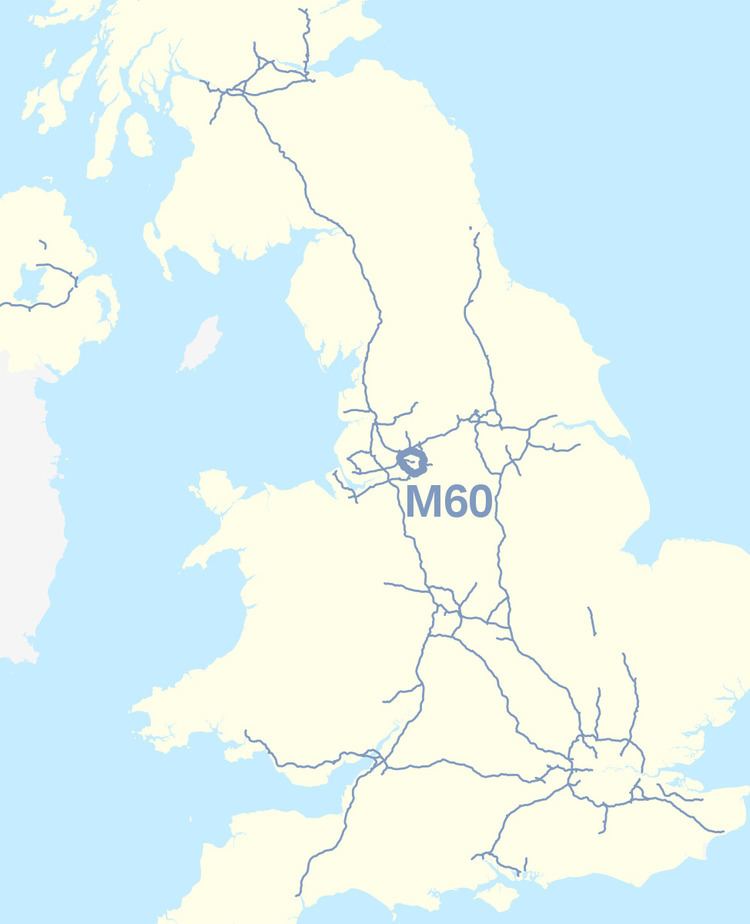Counties: Greater Manchester County Greater Manchester | Length 58.1 km | |
 | ||
History: 1960-2000 (opened in sections as M62, M63 and M66, renumbered M60 in 2000) Major cities Manchester, Salford, Greater Manchester, Oldham | ||
The M60 motorway, Manchester Ring Motorway, or Manchester Outer Ring Road, is an orbital motorway in Greater Manchester, a metropolitan county in North West England. Built over a 40-year period, it passes through all Greater Manchester's metropolitan boroughs except for Wigan and Bolton. Most of the City of Manchester is encompassed within the motorway, except for the southernmost part of the city (primarily the Wythenshawe area and Manchester Airport), which are served by the M56.
Contents
Map of M60, Manchester M34, UK
The M60 is 36.1 miles (58.1 km) long and was renamed the M60 in 2000, with parts of the M62 and M66 and all of the M63 being amalgamated into the new route. The road forms part of the unsigned Euroroutes E20 and E22.
During 2008, the M60 was proposed as a cordon for congestion charging in Greater Manchester, although this was rejected in a referendum relating to the Greater Manchester Transport Innovation Fund. The M60 is the only true orbital motorway in the United Kingdom, as the M25 motorway in London is not, due to the Dartford Crossing being designated the A282.
History
The M60 was developed by connecting and consolidating the existing motorway sections of the M63, M62, and an extended M66. It came into existence as the M60 in 2000, with the completion of the eastern side (Junctions 19-24) opening in October.
The original plan called for a completely new motorway, but policy change led to the plan which created the current motorway. As soon as it opened, the motorway got close to its projected maximum volume on significant sections.
As an orbital motorway, it is equivalent to London's M25 motorway; unlike the M25, the M60 forms a complete loop. In 2004, a section of the northern M60 was the UK's busiest stretch of road, with an average of 181,000 vehicles per day using the stretch between junctions 16 and 17. Usually, the western side of the M25 motorway holds that distinction, but the M25's figures at the time were lower than normal due to roadworks starting.
In 2006 the section between junctions 5 and 6 was widened from three to four lanes each way and the section between junctions 6 and 8 was widened from two to three lanes each way with an additional two-lane collector/distributor road on either side of the main carriageways. Access for junctions 6 to 8 is only from the collector/distributor road. Some of the junctions were extensively re-modelled. As part of the project, the A6144(M) motorway, which connected to the M60 at junction 8, was downgraded and lost its motorway status.
The Greater Manchester congestion charge which would have affected drivers only during peak times coming off the M60 towards Manchester was rejected by a referendum on 12 December 2008.
Work to upgrade two sections of the M60 to a managed motorway system had been planned to commence in 2013. This would have included a new lane from junction 12 to 15 and a new lane from junction 8 to 12 near the Trafford Centre. Both these projects were subsequently cancelled in favour of a new project that includes speed cameras on this section but no additional lane or hard-shoulder running. An 'environmental assessment' was cited as the reason an additional lane will not be provided. Consequently, daily congestion on this section is expected to continue indefinitely. A combined approach was initiated in 2014, comprising managed motorway system and lane gain scheme. Work commmenced in July 2014 and is expected to be completed by August 2017
Legislation
Each motorway in England requires that a Statutory Instrument be published, detailing the route of the road, before it can be built. The dates given on these Statutory Instruments relate to when the document was published, and not when the road was built. Provided below is an incomplete list of the Statutory Instruments relating to the route of the M60.
Junctions
The junctions on the M60 are very closely spaced together, with an average distance of 1.3 miles between junctions. The recommended junction spacing for motorways is 1 every 10–20 miles. By comparison, the M6 motorway has an average distance of 5.3 miles between junctions.
Data from driver location signs are used to provide distance and carriageway identifier information.
